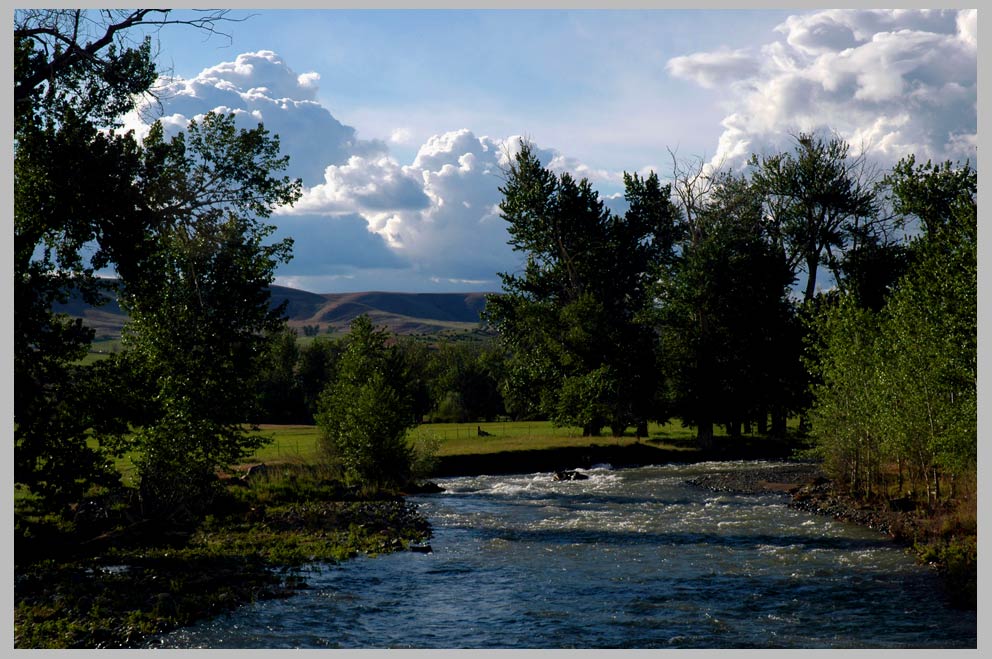
May Eagle Creek, a great North American river . . .

May Eagle Creek, a great North American river . . .
This is a view of Eagle Creek just north of
where it flows into the Powder River. You're
at about 660 m. here, and the Eagle runs another
60 kilometers all the way into the heart and center
of the High Wallowas, cresting at Eagle Cap at about
3000 meters. So along this river-run beautifully gradual
elevation gain of, in round numbers, about 2400 m.,
the river transitions from dry canyon country, to mountain
forest, to the austere and rugged and magnificent high
alpine where one can almost see forever, When I'm at my
little shoebox Office in Eagle Valley, the Eagle is
where my drinking water comes from. When I'm doing
fieldwork anywhere in the Wallowas, the sound of the
Eagle is never far away.
+
1958 is the year the salmon stopped running here.
There are now very few old-timers around who still
remember the time before the dams on the Snake, which
the Powder flows into, and the Columbia, which the
Snakes in turn flows into, were built. I feel and
sense this with my who being to be a total outrage.
That this natural integrity—a chance to see it and
become a part of it—has been taken away from me, and,
as I say, temporarily knotted up and blocked. Exactly
as in the area of the Alps where I've worked for years,
and hope to continue to work, the great River Rhien
watershed. Here, too, by some very strange twist of
fate, the salmon stopped their 1300 kilometer migration
from the North Sea to the Urnerlands in the central
part of the Swiss Alps also in the year of 1958.
My greatest fear is that these cycles have not only
been severely fragmented. They are now being erased
from consciousness.
My quest is to reverse this. By understanding inside
out the culture of thought that, in my view, underlies
the tremendous mistakes that were made. What I'm calling
the Earthrise Path of non-violence requires that we
understand the formative causes of what are essentially
problems of relationship at their deepest level, and not
as something 'out there,' that so-called 'bad guys' did,
but as part of ourselves, and our cultural history and heritage.
Remarkably, I would say exactly the same, without changing
a single word, about the problem of war. Behind the use
of force is always the idea of control. And as I've written
elsewhere, the idea of control may be appropriate in
non-living systems like machines, but is never appropriate
when we are dealing with living systems and life.
This is a view I intend to stand by and follow wherever
it leads, not because I'm for this, or against that particular
issue, but because, when seen as a whole, it is ethically
the right thing to do. Prima non nocere. First, do no harm.
On the road in the American Northwest.
KNOTS IN THE FLOW OF LIFE—the false way
of force, of power, of control
Force fades because it eventually breaks
what it is trying to force;
Power fades because it comes to depend
on energy from without, and thereby becomes
empty from within;
Control fades because it eventually breaks
what it tries to control.
So the false circle of contradictions comes
round necessarily in collapse. Dams, blocks,
knots in the flow of life, we either of our
own volition remove, or the intelligence
of Nature herself will do so for us.
TWO MINIATURES ON PLANTS & NOISE
(1) To love the plants is to know them. To know the plants is to make
them your friend. To make the plants your friend is to surround yourself
with teachers as old and wise as the Earth itself.
(2) Just as no one wanted to cloud the skies with the smoky haze of
accumulated car exhaust, or wanted streams to run muddy with plastic
bags and human waste, no one wanted the world to become a noisy
place. But noisy it is, all the same.
And, now that noise has become a part of practically every landscape—
even the most isolated and highest mountain ranges have jets roaring
above them—how shall we ever know what the deeper, more subtle
effects of noise on the human psyche really are? Or on Nature as a
whole? For the question has in a way become: where are the untouched
control groups to be found? And where are we to find even a single
researcher who has not been to some extent profoundly conditioned—
even while still in the womb—by a sea of surrounding noise?
My guess is that noise works on the mind something like a slowly
contracting air-tight room. As the noise levels increase, the walls of
the room close in and the pressure builds. Finally, one finds one’s face
pushed up against the wall, until one can no longer hear oneself talk,
or even think. An ur-scream of almost unbearable angst would almost
certainly be the result.
| click for full-screen |
Click on image or here to view / order the above postcard at my CliffCard Dollar Shop on zazzle.com
Or go to my main online store featuring more cards, books, prints, & CD's at www.picture-poems.com/shop
NEW: To view / purchase high quality prints & matted frames
at the Photoweek Northwest online store, SLIDESHOW
http://picturepoems.zenfolio.com/
All Photographs & texts by Cliff Crego © 2011 picture-poems.com
(created: VI.1.2008)